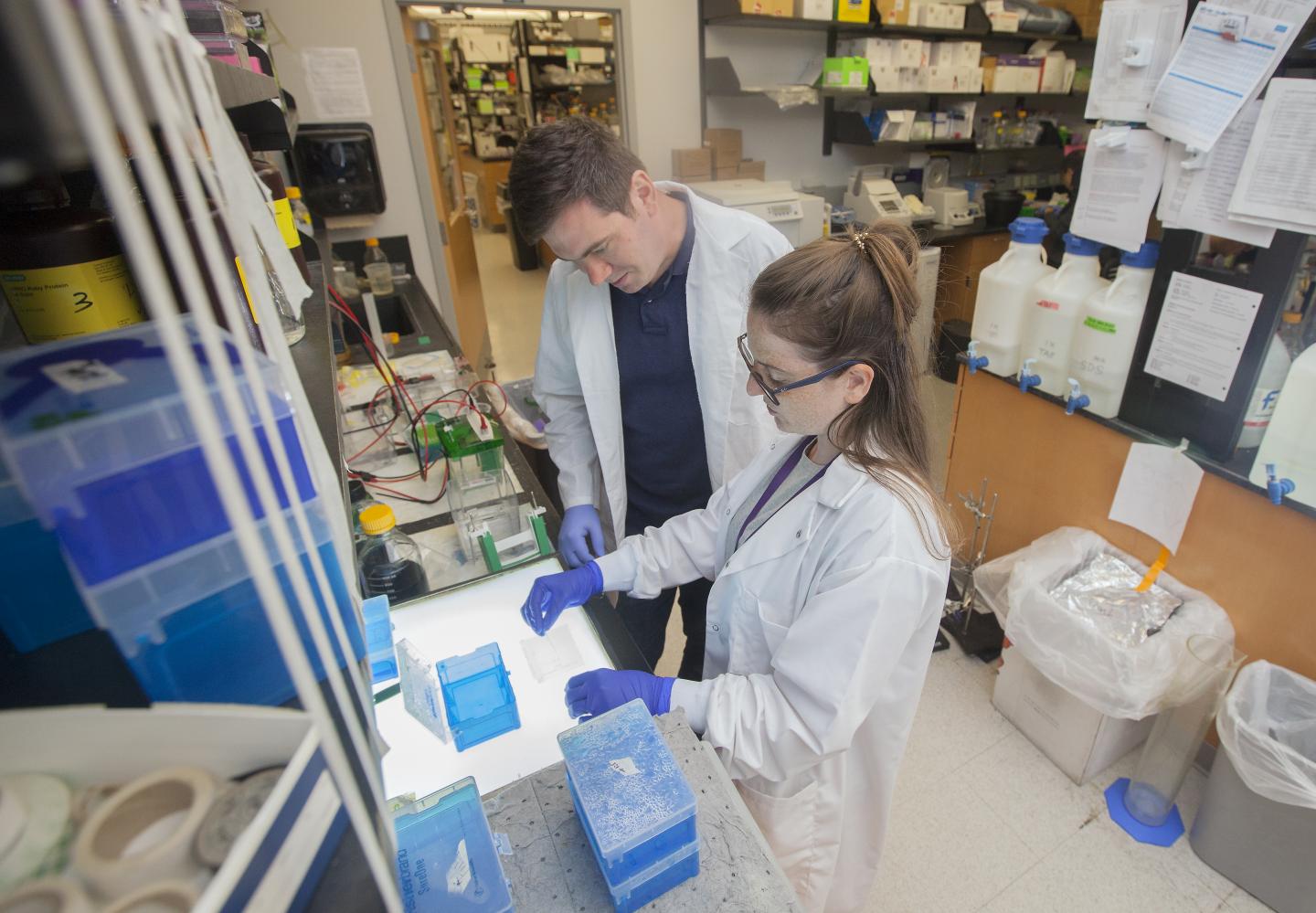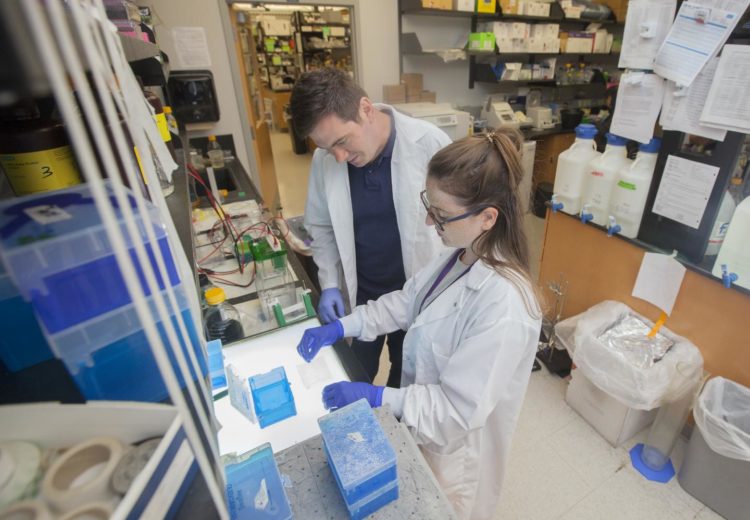
Credit: Sarah Pack, Medical University of South Carolina
Some of the greatest insights into cancer and how to treat it come when basic scientists and cancer biologists and clinicians collaborate.
Such a collaborative team at the Medical University of South Carolina (MUSC) recently reported in Nature Communications that they had obtained 3D structural snapshots of the enzyme Cdc34, a key regulator of cell biology and a target for cancer therapeutics.
These structures, along with studies in human cells, have revealed key features of this enzyme that are important for its regulation of cell growth and activity. These unique features could present opportunities for rational design of novel cancer therapeutics.
The team was led by National Institutes of Health-funded researcher Shaun K. Olsen, Ph.D., an assistant professor in the Department of Biochemistry and Molecular Biology at MUSC and a member of the Developmental Cancer Therapeutics Program at Hollings Cancer Center.
It included biochemists who study how the body’s proteins function at a molecular level, and cancer biologists and clinicians who could extend the findings in a biological context in human cancer cells.
“I chose to focus on Cdc34 first because of its clinical relevance,” said Katelyn Williams, first author of the published research and an MUSC M.D./Ph.D. student. “My clinical interest is pediatric hematology/oncology, and Cdc34 is a crucial regulator of many biological processes and functions abnormally in many cancers.”
Cdc34 is a central player in a cascade of E1-3 enzymes that interact with the signaling molecule ubiquitin to regulate cell growth and activity.
Within this system, Cdc34 labels proteins that normally block cell growth with ubiquitin, in a way that specifically targets them for disposal by the cellular trash compactor biologists call the proteasome.
When Cdc34 is unable to function properly, these negative regulators of cell growth accumulate and put the brakes on cell growth, which is the feature that makes is of interest for cancer therapeutics.
Developing a therapy to target the E1 enzyme, which is at the top of the cascade and affects everything below it, could have many unintended consequences. Instead targeting Cdc34, an E2 enzyme further down the cascade, could be just as effective and far safer.
“If you target the E1 enzyme, everything downstream of it gets turned off, which includes thousands of different pathways,” explained Olsen. “If you specifically target one of the E2s, however, it is just a small shunt of the overall repertoire of ubiquitin pathways that get turned off while everything else can function normally. It would represent a far more precise approach.”
To understand how best to target Cdc34, the team first had to better understand its structure. The structure of a protein is key to how it interacts with other molecules and performs its cellular duties.
Olsen and Williams isolated the protein from yeast and human cells and obtained a series of structural snapshots of Cdc34. This allowed them to determine how it clicks together with an E1 enzyme and ubiquitin like puzzle pieces. The MUSC team found that it does so via unique changes in shape.
“The big thing is that we are able to see this 3D accommodation by the E1 enzyme to ‘wiggle’ Cdc34 into its E2 binding site,” said Williams. “We also found, which we had not seen previously, that Cdc34 also changes its shape to interact with the E1.”
After exploring this with proteins from yeast, Olsen and Williams worked with Hollings cancer researcher Alan Diehl, Ph.D., and his lab to confirm the phenomenon in human cancer cells as well.
Because many of the details of Cdc34 mechanism that were discovered in this work are unique to this particular enzyme, it may be possible for medical scientists to target Cdc34 specifically as a means of developing new cancer therapeutics.
While drug development may be in the future for Cdc34 and the proteins it binds, much more work remains before these findings affect clinical care.
However, that does not diminish the significance of this work, and the excellent example it sets for biomedical researchers.
“This is an excellent example of the power of team science where the overall impact of the work is greater than the sum of the parts as a result of synergistic areas of expertise,” explained Olsen. “In this case, Dr. Diehl’s team of outstanding cancer biologists extended our structural and biochemical findings into a biological context, a crucial step in potentially translating our work into the clinic.”
###
The content of the research summarized here is solely the responsibility of the authors and does not necessarily represent the official views of the National Institutes of Health.
About the Medical University of South Carolina
Founded in 1824 in Charleston, the Medical University of South Carolina (MUSC) is the oldest medical school in the South, as well as the state’s only integrated, academic health sciences center with a unique charge to serve the state through education, research and patient care. Each year, MUSC educates and trains more than 3,000 students and 700 residents in six colleges: Dental Medicine, Graduate Studies, Health Professions, Medicine, Nursing and Pharmacy. The state’s leader in obtaining biomedical research funds, in fiscal year 2018, MUSC set a new high, bringing in more than $276.5 million. For information on academic programs, visit http://musc.
As the clinical health system of the Medical University of South Carolina, MUSC Health is dedicated to delivering the highest quality patient care available, while training generations of competent, compassionate health care providers to serve the people of South Carolina and beyond. Comprising some 1,600 beds, more than 100 outreach sites, the MUSC College of Medicine, the physicians’ practice plan, and nearly 275 telehealth locations, MUSC Health owns and operates eight hospitals situated in Charleston, Chester, Florence, Lancaster and Marion counties. In 2019, for the fifth consecutive year, U.S. News & World Report named MUSC Health the number one hospital in South Carolina. To learn more about clinical patient services, visit http://muschealth.
MUSC and its affiliates have collective annual budgets of $3 billion. The more than 17,000 MUSC team members include world-class faculty, physicians, specialty providers and scientists who deliver groundbreaking education, research, technology and patient care.
About Hollings Cancer Center
The Hollings Cancer Center at the Medical University of South Carolina is a National Cancer Institute-designated cancer center and the largest academic-based cancer research program in South Carolina. The cancer center comprises more than 200 physicians and scientists and 20 academic departments. It has an annual research funding portfolio of more than $40 million and a dedication to reducing the cancer burden in South Carolina. Hollings offers state-of-the-art diagnostic capabilities, therapies and surgical techniques within multidisciplinary clinics that include surgeons, medical oncologists, radiation therapists, radiologists, pathologists, psychologists and other specialists equipped for the full range of cancer care, including more than 200 clinical trials. For more information, visit http://www.
Media Contact
Heather Woolwine
[email protected]
843-792-7669
Related Journal Article
http://dx.





